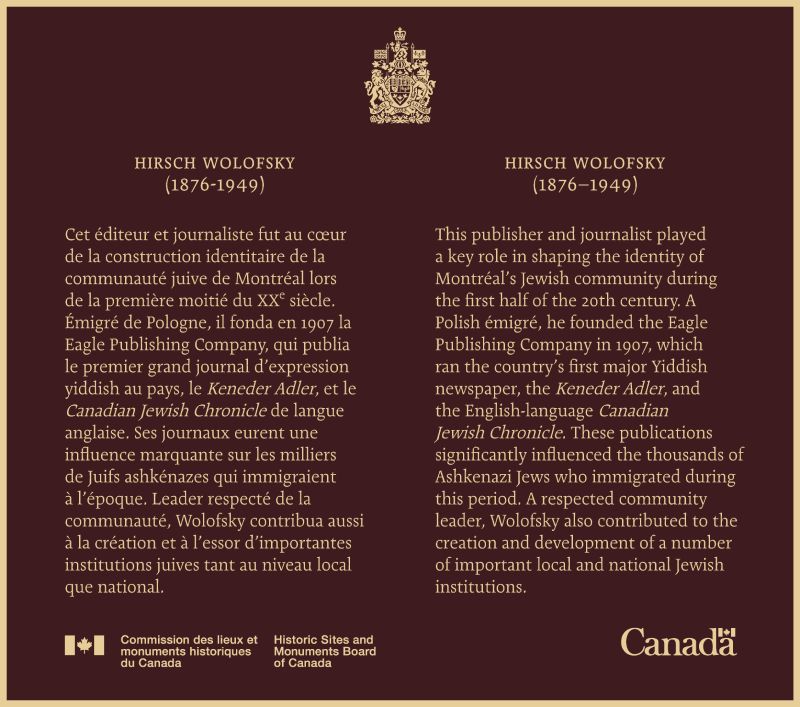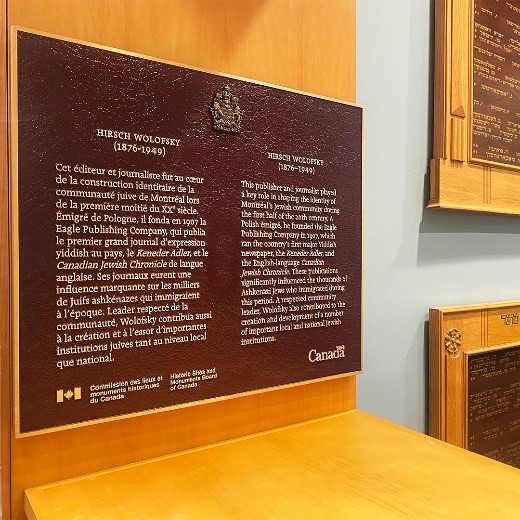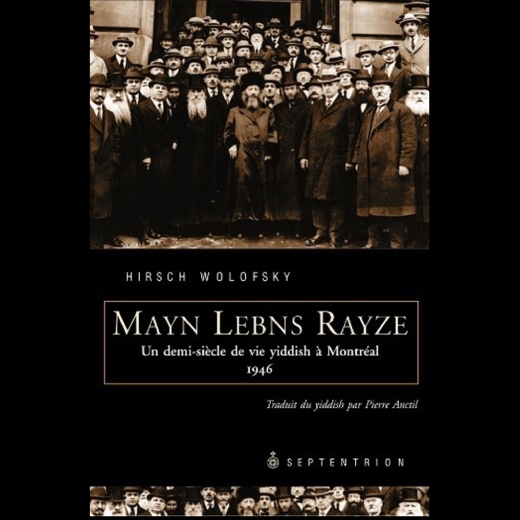Hirsch 'Harry' Zvi Wolofsky National Historic Person (1876-1949)

Hirsch «Harry» Zvi Wolofsky was designated as a national historic person in 2007.
Historical importance: Played a key role in the shaping of the Montréal Jewish community's identity in the first half of the 20th century; 1907, founded the Eagle Publishing Company.
Commemorative plaque: Jewish Public Library, Cummings House, 5151 Côte-Sainte-Catherine Road, Montréal, QuebecFootnote 1
Hirsch Wolofsky (1876-1949)
This publisher and journalist played a key role in shaping the identity of Montréal’s Jewish community during the first half of the 20th century. A Polish émigré, he founded the Eagle Publishing Company in 1907, which ran the country’s first major Yiddish newspaper, the Keneder Adler, and the English-language Canadian Jewish Chronicle. These publications significantly influenced the thousands of Ashkenazi Jews who immigrated during this period. A respected community leader, Wolofsky also contributed to the creation and development of a number of important local and national Jewish institutions.
Hirsch (Harry) Zvi Wolofsky (1876-1949)

© Parks Canada
A pioneer in Canadian Jewish journalism, Hirsch Wolofsky was a publisher and journalist, who played a key role in the shaping the identity of Montréal’s Jewish community in the first half of the 20th century. In 1907, he founded the Eagle Publishing Company, which, under his leadership, published the first important Yiddish newspaper in Canada, the Keneder Adler (which operated between 1907 and 1988) and its English-language equivalent, the Canadian Jewish Chronicle (1914-1976). For more than 40 years, through his newspapers and his personal initiatives, Wolofsky actively contributed to the establishment and development of a number of local and national Jewish institutions, including the Canadian Jewish Congress (founded in 1919), the Jewish Community Council of Montreal (1923), the United Talmud Torah of Montreal (1917), and the Montreal Jewish Library (1914). For all of these reasons, Harry Wolofsky stands as an important figure in Canada’s history.
Born in the almost exclusively Jewish town of Szydlowiec, Poland, on 15 September 1876, Hirsch Wolofsky sought what so many immigrants wanted, a better, more secure life in North America, and immigrated to Canada in 1900. Working successively as a tailor and a fruit dealer, he transformed the tragedy of the loss of his business to a fire into an opportunity to follow his preferred career path, journalism. In 1907, he founded the Eagle Publishing Company, which printed the first influential Yiddish-language daily newspaper in Canada, the Keneder Adler, which quickly became a pillar of Montréal’s rapidly-expanding Jewish community. Furthermore, through his support, he ensured the survival of one of this country’s oldest English-language Jewish newspapers, the Canadian Jewish Times. His publishing enterprises would have a profound effect on the evolution of Montréal’s Jewish community.

Wolofsky’s newspapers worked tirelessly both to educate and defend the interests of Canadian Jews. He supported the struggles of Jewish workers for recognition of their rights and spoke eloquently in favour of the preservation of the faith and culture of their forefathers in their adopted land. He encouraged his fellow Jews to integrate into Canadian society and improve themselves through education and economic advancement while preserving the core values of their faith. He especially encouraged the development of community-based social and charitable organizations that supported Jewish immigrants. His newspapers also offered a rare venue for the publication of Jewish literature by giving authors the chance to be published in both English and Yiddish. The rich religious and cultural life of Montréal’s current Jewish community is rooted in the work of pioneers such as Hirsch Wolofsky.
Backgrounder last update: 2017-12-19
The National Program of Historical Commemoration relies on the participation of Canadians in the identification of places, events and persons of national historic significance. Any member of the public can nominate a topic for consideration by the Historic Sites and Monuments Board of Canada.
- Date modified :